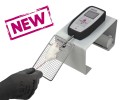Authors
Zieli?ska M, Chen C, Mokrowiecka A, Cygankiewicz AI, Zakrzewski PK, Sa?aga M, Ma?ecka-Panas E, Wla? P, Krajewska WM, Fichna J.
Lab
Department of Biochemistry, Faculty of Medicine, Medical University of Lodz, Lodz, Poland.
Journal
J Pharm Pharmacol.
Abstract
OBJECTIVE:
The aim of our study was to characterize the effect of P-317, a novel cyclic derivative of morphiceptin, on gastrointestinal (GI) motility and abdominal pain in mouse models mimicking symptoms of diarrhoea-predominant irritable bowel syndrome (IBS-D).
METHODS:
The effect of P-317 on mouse intestinal motility was characterized in vitro and in vivo in physiological and pathophysiological conditions. The antinociceptive action of P-317 was characterized in the mustard oil-induced abdominal pain model and the writhing test. Locomotor activity and grip-strength tests were used to evaluate the effect of P-317 in the central nervous system (CNS). To translate our study to clinical conditions, the semi-quantitative expression of ?-opioid receptors (MOP) and ?-opioid receptors (KOP) messenger RNA (mRNA) in human colonic samples from IBS-D patients was quantified.
KEY FINDINGS:
In vitro, P-317 (10(-10) -10(-6) M) inhibited colonic and ileal smooth muscle contractions in a concentration-dependent, ?-funaltrexamine and nor-binaltorphimine-reversible manner. In vivo, P-317 (0.1 mg/kg, i.p. and 1 mg/kg, p.o.) inhibited GI transit, displayed a potent antinociceptive action in abdominal pain tests and did not influence the CNS.
CONCLUSION:
P-317 produced a potent analgesic and antidiarrhoeal action in the mouse GI tract after oral administration. Given lower expression of MOP and KOP mRNA in IBS-D patients, P-317 is a promising peptide-based drug candidate for IBS-D therapy.
BIOSEB Instruments Used:
Grip strength test (BIO-GS3)

 Douleur - Allodynie/Hyperalgésie Thermique
Douleur - Allodynie/Hyperalgésie Thermique Douleur - Spontanée - Déficit de Posture
Douleur - Spontanée - Déficit de Posture Douleur - Allodynie/Hyperalgésie Mécanique
Douleur - Allodynie/Hyperalgésie Mécanique Apprentissage/Mémoire - Attention - Addiction
Apprentissage/Mémoire - Attention - Addiction Physiologie & Recherche Respiratoire
Physiologie & Recherche Respiratoire
 Douleur
Douleur Système Nerveux Central (SNC)
Système Nerveux Central (SNC)  Neurodégénérescence
Neurodégénérescence Système sensoriel
Système sensoriel Système moteur
Système moteur Troubles de l'humeur
Troubles de l'humeur Autres pathologies
Autres pathologies Système musculaire
Système musculaire Articulations
Articulations Métabolisme
Métabolisme Thématiques transversales
Thématiques transversales SFN2024: Venez rencontrer notre équipe sur le stand 876 à Chicago
SFN2024: Venez rencontrer notre équipe sur le stand 876 à Chicago 